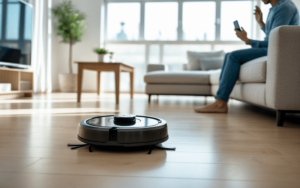Smart lighting solutions present a transformative approach to managing energy consumption in homes. With the advancements in technology, these systems utilize energy-saving light bulbs that can significantly lower electricity bills. By adopting smart lighting, individuals can reduce their energy costs by up to 80%.
The rise of products like Philips Hue and various alternatives has made it easier to create the perfect ambiance while also promoting sustainability. Smart lighting allows for flexible control, enabling users to adjust brightness and settings based on their needs and preferences. With features such as motion sensors and scheduling, energy waste becomes a thing of the past, contributing to a greener home environment.
Please note that this article contains affiliate links. As an Amazon Associate, we earn from qualifying purchases at no extra cost to you.
As people seek effective ways to save money and enhance their living spaces, exploring the potential benefits of smart lighting is essential. These energy-efficient solutions not only help in cutting costs but also elevate the comfort level of any home. It’s time for individuals to discover how smart lighting can make a positive difference in their lives.
Understanding Smart Lighting
Smart lighting has transformed how people illuminate their homes and workspaces. By utilizing cutting-edge technology, it offers features that greatly enhance energy efficiency, convenience, and control.
The Basics of Smart Lighting
Smart lighting refers to lighting systems that can be controlled remotely through smart devices such as smartphones, tablets, or voice-activated assistants. These systems typically use LED bulbs, which are already energy-efficient.
Users can adjust brightness, change colors, and create schedules for when lights turn on or off. Some smart lighting integrates with other smart home devices, allowing occupancy sensors to optimize energy usage based on whether a room is occupied.
Additionally, many smart lighting solutions enable users to control multiple lights at once, enhancing convenience. With energy monitoring features, users can track energy consumption, making it easier to identify potential savings.
How Smart Lighting Differs from Traditional Lighting
Traditional lighting relies on basic switches and dimmers, which limits control and efficiency. Smart lighting offers several advantages over its traditional counterparts.
For instance, smart lights can automatically adjust based on natural light availability, reducing the need for artificial light during the day. They can also be programmed to respond to specific events, such as turning on when someone enters a room or adjusting brightness based on the time of day.
Furthermore, smart lighting systems often have longer lifespans compared to standard bulbs. This longevity translates into reduced maintenance and replacement costs. By adopting smart lighting, users can achieve significant savings on electricity bills, with studies suggesting potential reductions of up to 80% in energy costs.
Strategies for Maximizing Energy Savings
Maximizing energy savings through smart lighting involves strategic usage patterns, innovative technologies, and integration with existing smart home systems. Each approach plays a vital role in reducing overall energy consumption.
Optimal Usage Patterns
Adopting optimal usage patterns can significantly lower energy costs. Users can implement task lighting, which focuses illumination only on areas that require it. This prevents energy waste from illuminating entire spaces unnecessarily.
Dimming features also contribute to savings. By adjusting brightness based on need, less energy is consumed when full brightness isn’t required. Scheduling lights to turn off during non-use hours ensures they only operate when necessary.
Users should also take advantage of natural light whenever possible. Positioning lighting to complement daylight reduces reliance on artificial sources. Simple actions like closing blinds on sunny days can promote energy efficiency.
Responsive Lighting Technologies
Responsive lighting technologies enhance energy efficiency through smart features. Motion sensors are vital, automatically turning lights on or off based on room occupancy. This significantly reduces energy use in vacant areas.
Smart bulbs equipped with adjustable settings allow users to transition between warm and cool lighting based on the time of day or task. This adaptability promotes comfort while keeping costs down.
Integrating light sensors can optimize usage further by adjusting lighting levels in response to available natural light. The result is a continuously efficient lighting solution that aligns with environmental conditions.
We may earn a small commission if you purchase through this link. Thank you for supporting our content!
Integration with Smart Home Systems
Connecting smart lighting to broader smart home systems maximizes energy savings. A central hub allows for cohesive management of lighting, heating, and cooling, providing real-time data on overall energy usage.
Users can set up routines that automatically adjust lighting based on their daily schedules. For example, lights can dim during movie nights or turn off when the last person leaves home.
Additionally, compatibility with platforms like Amazon Alexa or Google Assistant enables voice control for effortless management. This not only enhances convenience but also ensures lights are used efficiently, reducing potential energy waste.
Real-Life Examples and Case Studies
Smart lighting has demonstrated significant potential in reducing energy costs across various applications. Both residential and commercial settings have benefited from innovative technologies that enhance efficiency and sustainability.
Residential Success Stories
Many homeowners have adopted smart lighting solutions to save energy and reduce costs. For example, families using LED smart bulbs can adjust brightness through mobile apps.
- Energy Savings: According to studies, these homeowners have reported energy savings of up to 70%.
- Longevity: LED bulbs last 15-20 years, meaning less frequent replacements.
In a suburb, one family’s shift to a smart lighting system enabled them to cut their electricity bill by $300 annually. The integration of motion sensors ensures lights are off when rooms are unoccupied, further maximizing savings.
Commercial Energy Cost Reductions
Businesses are recognizing the financial benefits of smart lighting. In a notable case, a retail store implemented a smart lighting system that adjusted brightness based on customer traffic.
- Dynamic Adjustments: This system reduced energy usage during off-peak hours significantly.
- Cost Comparisons: The store experienced a 60% decrease in lighting costs within the first year.
Additionally, cities like Paris have adopted smart street lighting to save energy. The initiative included smart sensors that dim lights when no motion is detected. This approach has led to substantial reductions in municipal lighting expenses, demonstrating the effectiveness of smart technology in urban settings.
We may earn a small commission if you purchase through this link. Thank you for supporting our content!
Getting Started with Smart Lighting
Transitioning to smart lighting can be an exciting journey toward energy efficiency and convenience. Choosing the right products and understanding proper installation can make all the difference in maximizing benefits.
Choosing the Right Smart Bulbs and Fixtures
When selecting smart bulbs, it’s essential to consider compatibility with existing fixtures, smart home systems, and individual needs. Smart bulbs are often available in different types, including LED, which is energy-efficient and has a long lifespan.
Users can choose between color-changing bulbs or those with adjustable brightness for more control. Key features to look for include:
- Compatibility: Ensure they work with your smart home hub, like Samsung SmartThings or Amazon Alexa.
- Wattage: Check the wattage equivalent to ensure they provide adequate lighting.
- Lifespan: Prefer bulbs with longer life, usually rated for around 15,000 – 25,000 hours.
By focusing on these aspects, individuals can effectively enhance their home lighting while reducing energy consumption.
Installation Tips and Best Practices
Installing smart lighting doesn’t have to be complicated. Start by reading the manufacturer’s instructions for each product carefully. Most smart bulbs easily fit into standard fixtures.
- Turn Off Power: Always turn off power at the circuit breaker before installation to avoid electrical hazards.
- Download the App: Many smart bulbs require a companion app for setup. Download required applications beforehand.
- Follow Pairing Instructions: Pair bulbs with your smart home system following the prompts in the app.
Testing the lights
Conclusion
Smart lighting is more than just a trendy home upgrade; it’s an investment in energy efficiency, cost savings, and convenience. By integrating advanced technologies like energy-saving LED bulbs, customizable schedules, and voice control, smart lighting allows homeowners to reduce energy consumption by up to 80%.
Whether it’s dimming lights for the perfect ambiance or automatically turning them off when not in use, these systems make saving energy effortless.
The benefits extend beyond financial savings. Smart lighting contributes to a greener planet by reducing your carbon footprint and promoting sustainability.
With options like Philips Hue, LIFX, and Sengled, achieving these advantages has never been easier or more accessible.
So, take the leap toward a smarter, more energy-efficient home today. Not only will you enjoy the convenience and modern features of smart lighting, but you’ll also make a positive impact on your energy bills and the environment.
This article contains affiliate links, which means we may earn a commission if you purchase through our links, at no extra cost to you. As an Amazon Associate, we earn from qualifying purchases. Thank you for supporting our content!




